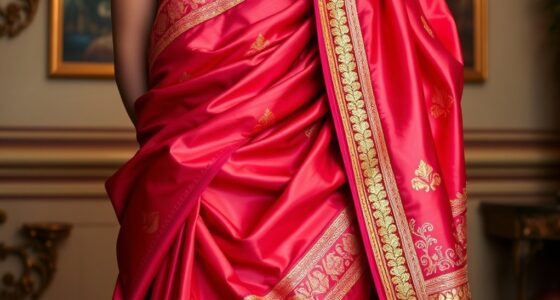Discover the secret to fearless styling by mastering print mixing, where you’ll learn to blend bold colors and patterns with confidence. Focus on color coordination to create harmony and use pattern variations to add interest without chaos. Practice combining different scales, textures, and placements to develop a cohesive, eye-catching design. As you refine your skills, you’ll discover how to push boundaries and make standout prints—keep exploring to open even more creative possibilities.
Key Takeaways
- Learn how to combine colors and patterns harmoniously for bold, eye-catching designs.
- Master color coordination techniques using color theory and palettes for visual harmony.
- Discover pattern blending methods, including layering, scaling, and contrasting for dynamic effects.
- Practice experimentation with sample prints to refine your skills and build confidence.
- Develop an intuitive sense of balance and cohesion to create fearless, standout styling.

Have you ever wondered how professional printers achieve eye-catching, vibrant results by combining different printing techniques? The secret lies in mastering the art of print mixing, where color coordination and pattern blending play crucial roles. When you understand how to balance hues and seamlessly merge patterns, your designs become more dynamic and visually compelling. This mastery isn’t just about choosing bold colors or contrasting patterns; it’s about knowing how to harmonize them to create a cohesive look that captures attention.
Color coordination is fundamental to successful print mixing. You want your colors to complement each other rather than clash. Think of it as creating a visual symphony, where each hue contributes to a harmonious overall effect. You can start by selecting a color palette that reflects the mood or message you want to convey. Using tools like color wheels helps you identify complementary, analogous, or monochromatic schemes, making it easier to build a balanced design. Incorporate shades that work well together to avoid chaos and confusion, ensuring your printed piece looks polished and professional. Additionally, understanding color theory can significantly enhance your ability to create visually appealing combinations.
Color harmony ensures your prints are visually appealing and professional.
Pattern blending takes this a step further. It involves combining different patterns—such as stripes, polka dots, florals, or geometric shapes—in a way that feels intentional, not chaotic. The key is to vary scale and complexity; pairing a bold, large-scale pattern with a subtle, smaller one creates visual interest without overwhelming the viewer. When blending patterns, consider their placement and orientation. Overlapping or layering patterns with precision can add depth and texture, making your design stand out. Remember, contrast is your friend here—mixing intricate patterns with simple ones helps guide the eye and maintains interest.
To master print mixing, start small. Experiment with different color combinations and pattern pairings on sample prints. Pay attention to how colors interact when printed side by side, and adjust your choices accordingly. As you gain confidence, scale up your projects, applying these principles to more complex designs. Digital tools and mockups are invaluable—they allow you to preview your work and make adjustments before committing to the final print. Over time, you’ll develop an intuitive sense for what works, enabling you to create bold, fearless designs that resonate.
In essence, print mixing is about balancing colors and patterns in a way that feels natural and intentional. Combining color coordination with pattern blending accesses creative potential and elevates your designs from ordinary to extraordinary. When you master these techniques, you gain the confidence to push boundaries, experiment boldly, and produce prints that truly stand out in any setting.
Frequently Asked Questions
What Are the Best Fabrics for Print Mixing?
When it comes to print mixing, you should focus on fabric textures and print scale. Choose fabrics like silk, cotton, or linen for their versatility and ease of mixing. Keep print scale in mind: pair large prints with smaller ones to create balance. Mixing different textures adds depth and interest, making your styling fearless. Experiment with contrast and harmony to develop your unique print mixing style confidently.
How Do I Choose Complementary Color Palettes?
You might find that selecting complementary color palettes feels like balancing between harmony and contrast. Trust color theory principles—think about colors opposite each other on the wheel or those that share undertones. Focus on pattern coordination by pairing prints with similar or contrasting hues. This approach helps you create visually appealing outfits that feel intentional and stylish, even if you’re technically venturing into bold print mixing territory.
Can Print Mixing Be Suitable for Formal Occasions?
Print mixing can be suitable for formal occasions if you choose the right print fabric and print size. Opt for subtle, sophisticated patterns like pinstripes or small florals, and keep the print size balanced to avoid overwhelming your look. Pair these with classic pieces and neutral accessories to maintain elegance. When done thoughtfully, print mixing adds personality to formal attire without sacrificing refinement.
How to Balance Proportions With Busy Prints?
You might think busy prints overwhelm your look, but with proper scale balancing, you can create harmony. Start by pairing large prints with solid, neutral pieces to avoid pattern clash, while smaller prints can be mixed more freely. Focus on maintaining pattern harmony through consistent color palettes and thoughtful proportioning. This approach guarantees your outfit looks balanced and stylish, preventing any one print from dominating the overall look.
What Accessories Enhance Mixed Print Outfits?
You can elevate mixed print outfits with statement accessories and footwear. Choose bold, eye-catching statement accessories like chunky necklaces or oversized earrings to add a focal point. Statement footwear, such as colorful heels or patterned boots, also amps up your look. These pieces draw attention and create harmony within your busy prints, making your ensemble feel intentional and stylish. Don’t shy away from mixing textures and colors for a truly fearless fashion statement.
Conclusion
Now that you’ve unveiled the secrets of print mixing, you’re ready to conquer fearless styling like a pro. Think of it as dancing in a vibrant jungle—you blend bold patterns and colors with confidence, creating your unique rhythm. Remember, practice makes perfect, so keep experimenting and embracing your personal style. With these tips, you’ll turn heads and set trends, proving that fashion is your playground. So go ahead—dare to mix and master your look!








